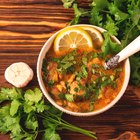
Steve Jennings/Getty Images Entertainment/Getty Images
Dinner menus vary widely, depending on the formality of the event and personal dining preferences. While tradition suggests serving many courses for a ceremonial occasion, a casual mid-week meal may consist of a single plate of food. Overall, planning a successful menu takes into account nutritional needs and gastronomic pleasure.
Formal Dinner Menu
Formal dinners can be lengthy affairs, as five or six separate courses are common. Hosts offer appetizers before the main meal to stimulate the appetite. Shrimp cocktail and oysters on the half shell are two traditional examples. The soup course follows. Thin purees like vichyssoise—cold potato and leek soup—and cream of sorrel soup leave room for the next courses. A fish course often consists of a fillet or steak of a larger fish, such as salmon or cod, or a small, whole fish. The modern meat course includes either poultry or red meat, while a traditional, formal meal might offer a poultry or game course before a meat course. While American restaurants generally serve salad before the meat course or at the beginning of a meal, proper etiquette dictates that the salad course should follow the meat course, according to Fordham University Hospitality Services. The dessert course may include both fruit and a frozen or baked confection. Coffee service completes a formal meal.
Balanced Dinner Menu
The United States Department of Agriculture suggests eating a balanced dinner containing foods from every food group to get the recommended amount of nutrients. Depending on your protein intake earlier in the day, a dinner menu may include 3 to 5 oz. of lean meat, fish or beans. Grain options include bread, rice and pasta, although the USDA recommends eating whole grains for at least half of the grains you consume. Vegetables make up a significant part of a balanced dinner. A serving of cooked vegetables, like spinach, broccoli or peas, can be about half the size of the suggested cup of salad. A glass of fat-free milk provides additional calcium.
Italian Dinner Menu
An Italian dinner menu rarely contains a main course, but instead is comprised of several smaller plates of food served in succession. Italian food writer Marcella Hazan suggests looking for foods that complement each other and fit loosely within a theme. Regional specialties and seasonal ingredients provide some possibilities for planning a dinner. A light seafood menu is appropriate for a summer dinner menu, while a fall feast may include truffles and wild game. Popular appetizers include toasted and grilled breads with roasted, grilled or marinated vegetable accompaniments. Options for first courses include soup, pasta or risotto. A second course generally consists of a modest serving of meat or fish served with one of more vegetable side dishes. Salad traditionally comes next. For a meal of two or more courses, Hazan suggests fruit served as a dessert.
Indonesian Dinner Menu
Nasi Padang is a traditional Indonesian rice dinner. Unlike multi-course meals, Indonesians serve this dinner of up to two dozen different menu items and a rice centerpiece at the same time. This room-temperature food consists of three basic components. "Gulai" are quick-simmered coconut stews. Generously spiced "balado" dishes contain crushed green or red chili peppers. Indonesians grill barbecued "pangang" over coconut shells. Guests compose their own meals from the wide assortment of food on the table.
Related Articles

The Parts of a Traditional French Meal

Vegetarian Menus for Large Groups

Ways to Serve Dinner at a Wedding ...

Foods Served at a Spanish Wedding

Victorian Banquet Menus

Simple Menu Ideas for Small Wedding ...

Easy Wedding Potluck Meals
A Funeral Lunch Menu
Menu for a Seafood Buffet

How to Plan a Traditional Jewish ...

Food Ideas for a Nautical Party

Golf Tourney Buffet Ideas

The Difference Between the Rehearsal ...

Formal Dinner Menu Ideas

How to Cook Drum Fish

How to Set a Salad Bar Buffet for a ...

How to Cook Canned Gefilte Fish
How to Plan a Reception With Finger ...

Facts About Italian Cuisine

How to Plan a Brunch Menu
References
- “Essentials of Classic Italian Cooking”; Marcella Hazan; 1992
- “Saveur”; Tableful of Spice; James Oseland; April 2002
Writer Bio
Fiona Fearey has an undergraduate degree from Temple University and a master's degree from New York University. She has been a freelance writer and editor for over five years. She has written for Pluck on Demand and various other websites. Other professional experience includes education, the arts and decorative painting.
Photo Credits
Steve Jennings/Getty Images Entertainment/Getty Images